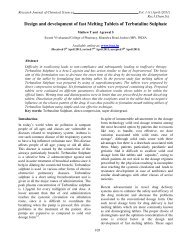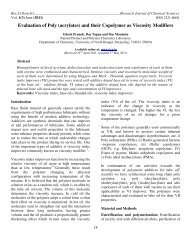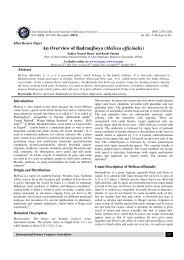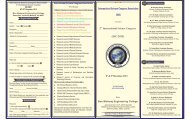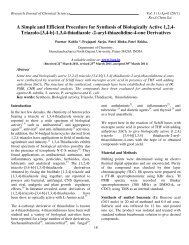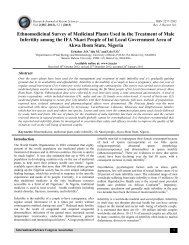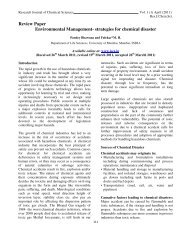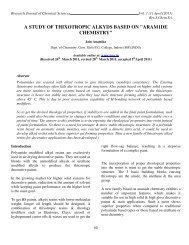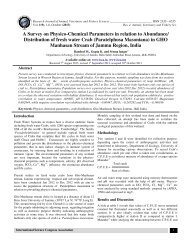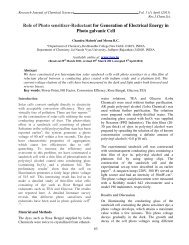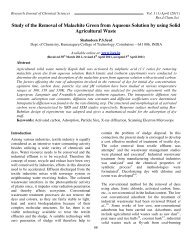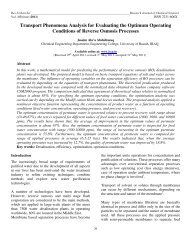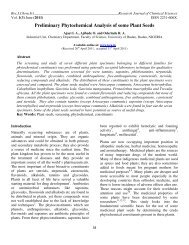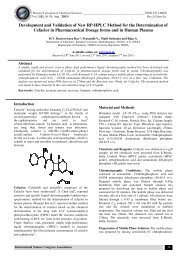Invitro Cytotoxic Activity of Marsilea Quadrifolia Linn of MCF-7 ... - ISCA
Invitro Cytotoxic Activity of Marsilea Quadrifolia Linn of MCF-7 ... - ISCA
Invitro Cytotoxic Activity of Marsilea Quadrifolia Linn of MCF-7 ... - ISCA
Create successful ePaper yourself
Turn your PDF publications into a flip-book with our unique Google optimized e-Paper software.
International Research Journal <strong>of</strong> Medical Sciences __________________________________________________<br />
Vol. 1(1), 10-13, February (2013)<br />
Int. Res. J. Medical Sci.<br />
<strong>Invitro</strong> <strong>Cytotoxic</strong> <strong>Activity</strong> <strong>of</strong> <strong>Marsilea</strong> <strong>Quadrifolia</strong> <strong>Linn</strong> <strong>of</strong> <strong>MCF</strong>-7 Cells <strong>of</strong><br />
Human Breast Cancer<br />
Uma R.* and Pravin B.<br />
Dept. <strong>of</strong> Bio-chemistry, Dwaraka Doss Goverdhan Doss Vaishnav College, Arumbakkam, Chennai-600 106, Tamilnadu, INDIA<br />
Abstract<br />
Available online at: www.isca.in<br />
Received 29 th November 2012, revised 10 th February 2013, accepted 20 th February 2013<br />
The aim <strong>of</strong> the present study was to evaluate the invitro cytotoxic activity <strong>of</strong> methanol, aqueous and ethyl acetate<br />
extracts <strong>of</strong> leaves <strong>of</strong> <strong>Marsilea</strong> quadrifolia on <strong>MCF</strong>-7 cells from human breast cancer . Qualitative phytochemical<br />
screening tests were performed to detect phytochemicals in the extracts. Antioxidant activity <strong>of</strong> the plant extract<br />
was then characterised using α, α Diphenyl_β- picryl hydrazyl (DPPH) radical scavenging method. Antioxidant activity<br />
using DPPH was found to increase, in concentration dependent manner. All the three extracts ethylacetate, aqueous and<br />
methanol exhibited potential antioxidant activity with an IC50 value <strong>of</strong> 10, 125 and 25µg/ml respectively, when<br />
compared to the standard BHT with an IC50 value <strong>of</strong> the 7.5 µg/ml. The cytotoxic activity <strong>of</strong> the extracts <strong>of</strong><br />
<strong>Marsilea</strong> quadrifolia on <strong>MCF</strong>-7 cells from human breast cancer was investigated invitro 3-(4) 5-Dimethyl-thiazol-zyl)-<br />
2,5 biphenyl tetrazolium bromide ( MTT). The results showed decreased cell viability and cell growth inhibition in<br />
dose dependent manner. The IC50 value <strong>of</strong> standard 5 fluorouracil, methanol,ethylacetate and aqueous extracts were<br />
9.3, 39.06, 47.82 and 187.5µg/ml respectively. Methanol and ethyl acetate extracts <strong>of</strong> M.quadrifolia demonstrated strongest<br />
antioxidant and anti-proliferative activities. The findings from this study indicated that methanol and ethylacetate extracts <strong>of</strong><br />
M.quadrifolia leaf possessed vast potential as medicinal drug especially in breast cancer treatment. .<br />
Keywords: <strong>Marsilea</strong> quadrifolia, <strong>MCF</strong>-7 cell lines, MTT Assay, <strong>Cytotoxic</strong> activity, GC-MS, DPPH<br />
Introduction<br />
For centuries, people have been using plants for their<br />
therapeutic values. Today 85,000 plants have been documented<br />
for therapeutic use globally 1 . Antimicrobial and cytotoxic<br />
agents from natural, especially plant sources may be easily<br />
accessible and might be cheaper with minimal side effects.<br />
The screening <strong>of</strong> the plant extracts has been <strong>of</strong> great<br />
interest to scientists in the search for new drugs for<br />
effective treatment <strong>of</strong> several diseases 2 . Cancer is one <strong>of</strong><br />
the most dangerous disease in human’s and presently there<br />
is considerable scientific discovery <strong>of</strong> new anticancer<br />
agents from natural products. Drug discovery from<br />
medicinal plants has played an important role in the<br />
treatment <strong>of</strong> cancer and indeed, over the last half century<br />
most <strong>of</strong> the plant secondary metabolites and their<br />
derivation have been used towards combating cancer 3,4 .<br />
M.quadrifolia <strong>Linn</strong> is an aquatic fern belongs to the family<br />
(<strong>Marsilea</strong>ceae ) commonly named has Aaraikeerai in Tamil,<br />
Neeraral in Malayalam and Cauptiya, Sunsuniya in Hindi.<br />
It is an aquatic fern bearing 4 parted leaf resembling ‘4-<br />
leaf clover’ (trifolium). Leaves floating in deep water or erect<br />
in shallow water or on land. It possess long stalked petiole<br />
with 4 clover like lobes and are either held above the<br />
water or submerged. Juice made from the leaves is diuretic<br />
and febrifuge and also used to treat snake bite and applied<br />
to abscesses etc 5 . The plant is anti-inflamatory, diuretic,<br />
depurative, febrifuge and refrigerant 6 . Plants pacifies vitiated<br />
pitta, cough, bronchitis, diabetes, psychiatric diseases, eye<br />
diseases, diarrhea and skin disease. Previous studies have<br />
shown that antibacterial cytotoxic and antioxidant activity<br />
<strong>of</strong> crude extract <strong>of</strong> <strong>Marsilea</strong> quadrifolia 7 . The present study<br />
was performed to characterize the anticancer activity <strong>of</strong><br />
M.quadrifolia extracts to validate its medicinal potential.<br />
Material and Methods<br />
Plant Material: Fresh plants <strong>of</strong> M.quadrifolia was collected<br />
from Tanjore district <strong>of</strong> Tamilnadu State, in South India<br />
and was authenticated by Pr<strong>of</strong>. P. Jayaraman, Director<br />
Institute <strong>of</strong> Herbal Botany Plant Anatomy Research centre,<br />
West Tambaram, Chennai-45, India.<br />
Preparation <strong>of</strong> Plant Extract: The leaves <strong>of</strong> M.quadrifolia<br />
was washed, shade dried, pulverized in a blender and kept<br />
in a air tight container for experimental uses. 20g <strong>of</strong> dired<br />
powder was soaked in 200ml methanol, water and<br />
ethylacetate, kept in orbital shaker for 24hrs at 20ºC for<br />
100rpm. The extract was filtered through a cotton plug<br />
followed by whatman filter paper no.1 and the extracts were<br />
allowed for evaporation. 100mg <strong>of</strong> the extract was<br />
dissolved in 1ml <strong>of</strong> Dimethyl sulphoxide (DMSO) to prepare<br />
the stock solution (100mg/ml).<br />
Phytochemical Screening: Qualitative chemical tests were<br />
carried out using extracts from plant to identify the<br />
phytochemicals 8,9 .<br />
International Science Congress Association 10
International Research Journal <strong>of</strong> Medical Sciences ________________________________________________________________<br />
Vol. 1(1), 10-13, February (2013)<br />
Int. Res. J. Medical Sci.<br />
DPPH radical scavenging activity: Free radical scavenging<br />
capacity was evaluated on the basis <strong>of</strong> the scavenging activity <strong>of</strong><br />
DPPH by measuring the reduction <strong>of</strong> absorbance at 517 nm 10 .<br />
Principle: The DPPH assay measures hydrogen atom (or one<br />
electron) donating activity and hence provides a measure <strong>of</strong><br />
free-radical scavenging antioxidant activity. DPPH is a purplecoloured<br />
stable free radical and will form yellow color when it<br />
was reduced as diphenyl picryl hydrazine complex.<br />
Crude methanol, aqueous and ethylacetate extracts <strong>of</strong><br />
M.quadrifolia were redissolved in methanol and various<br />
concentrations <strong>of</strong> each extract were prepared. The assay mixture<br />
contained in a total volume <strong>of</strong> 1 mL consists <strong>of</strong> 500 µL <strong>of</strong> the<br />
extract, 125 µL <strong>of</strong> freshly prepared DPPH solution (1mM in<br />
methanol) and 375 µL <strong>of</strong> solvent (methanol). The contents were<br />
mixed vigorously in a vortex mixer for 10 s and incubated at<br />
room temperature in the dark (wrapped with Aluminum foil) for<br />
30 min. The absorbance was read at 517 nm using a<br />
spectrophotometer. In each experiment, the tested sample alone<br />
in methanol was used as blank while the DPPH solution alone in<br />
methanol was used as control. All experiments were carried out<br />
in triplicate. Butylated hydroxy toluene was used as a standard.<br />
The radical scavenging activity <strong>of</strong> samples corresponded to the<br />
intensity <strong>of</strong> quenching DPPH.<br />
The results were expressed as percentage inhibition.<br />
% inhibition = [(A control – A sample)/ A control] x 100<br />
where A control and A sample are the absorbance values <strong>of</strong> the<br />
control and test sample, respectively. The effective<br />
concentration <strong>of</strong> sample required to scavenge DPPH radical by<br />
50% (EC50) was obtained by linear regression analysis <strong>of</strong> doseresponse<br />
curve plotting between % inhibition and concentration<br />
The EC50 value for each sample, defined as the concentration<br />
<strong>of</strong> the test sample leading to 50% reduction <strong>of</strong> the initial DPPH<br />
concentration, was calculated from the non linear regression<br />
curve <strong>of</strong> Log concentration <strong>of</strong> the test extract (µg ml-1) against<br />
the mean percentage <strong>of</strong> the radical scavenging activity.<br />
Evaluation <strong>of</strong> cytotoxic activity: The human Breast<br />
adenocarcinoma (<strong>MCF</strong>-7) cell line was obtained from the<br />
NCCS., Pune, India.<br />
The assay was carried out using (3-(4, 5-dimethyl thiazol-2yl)-<br />
2, 5-diphenyl tetrazolium bromide (MTT). MTT is cleaved by<br />
mitochondrial enzyme dehydrogenase <strong>of</strong> viable cells, yielding a<br />
measurable purple product formazan. This formazan production<br />
is directly proportional to the viable cell number and inversely<br />
proportional to the degree <strong>of</strong> cytotoxicity<br />
Preparation <strong>of</strong> working herbal extracts: 0.5ml <strong>of</strong> stock (100<br />
mg/ ml) herbal extract was dissolved in 4.5 ml <strong>of</strong> DMSO for a<br />
concentration <strong>of</strong> 10 mg/ ml. The fresh working suspension<br />
filtered through 0.45 µm membrane filter prior to the assay.<br />
Using the 1mg/ ml concentration herbal extract nine serial<br />
doubling dilutions <strong>of</strong> the extract <strong>of</strong> 500µl each was prepared in<br />
DMSO to get the concentration <strong>of</strong> the extract as indicated and<br />
the diluted extracts transferred to 10 wells <strong>of</strong> a 12 well culture<br />
plate. 500 µl <strong>of</strong> 48h culture <strong>of</strong> <strong>MCF</strong> 7 cell lines at a<br />
concentration <strong>of</strong> 105 cells/ ml was added to each well. Two<br />
control wells received only cell suspension without plant<br />
extract. The plate incubated in a humidified CO 2 incubator at<br />
37°C for 4 - 6 h. The plate was microscopically examined for<br />
confluent monolayer <strong>of</strong> cells, turbidity and toxicity.<br />
MTT assay 11-13 : After incubation, the medium from the wells<br />
aspirated carefully and discarded. Each well washed with<br />
Eagle’s Minimum Essential Medium (EMEM) without Fetal<br />
Calf Serum (FCS). 200µl <strong>of</strong> MTT solution (5mg MTT/ ml <strong>of</strong><br />
PBS, pH 7.2) added to each well. The plate incubated for 6-7 h<br />
at 37°C in a CO 2 incubator with 5% CO 2 . After incubation 1ml<br />
<strong>of</strong> DMSO added to each well and mixedwith pipette and left for<br />
45s at room temperature. Purple formazan formed in the wells.<br />
Cell control and solvent control were included in each assay to<br />
compare the full cell viability in cytotoxicity and antitumor<br />
activity assessments. The suspension transferred to a<br />
spectrophotometer cuvette and the optical density (OD)<br />
measured at 540nm using DMSO as blank. The % cell viability<br />
was calculated with the following formula:<br />
Cell viability % = Mean OD <strong>of</strong> wells receiving each plant<br />
extract dilution / Mean OD <strong>of</strong> control wells x 100.<br />
Results and Discussions<br />
Phytochemical Screening - Qualitative phytochemical<br />
screening <strong>of</strong> the different solventextracts <strong>of</strong> M.quadrifolia<br />
revealed the presence <strong>of</strong> carbohydrates, alkaloids, steroids,<br />
Tannins, Terpenes, Protein, Flavonoids and anthroquinone,<br />
absence <strong>of</strong> Glycosides and Saponin were summarized in the<br />
table-1 Antioxidant <strong>Activity</strong> - DPPH is one <strong>of</strong> the free<br />
radical widely used for testing preliminary radical<br />
scavenging activity <strong>of</strong> compound or a plant extract. All the<br />
three extracts (methanol, aqueous and ethylacetate) <strong>of</strong><br />
M.quadrifolia exhibited potential antioxidant activity were<br />
depicted in the figure 1.<br />
The ethylacetate extract <strong>of</strong> M.quadrifolia exhibited 50%<br />
DPPH free radical scavenging activity at the lowest<br />
inhibitory concentration (IC50 : 10µg/ml). The methanol and<br />
aqueous extracts <strong>of</strong> plant also revealed antioxidant activity<br />
with an IC50; 25µg/ml and 125µg/ml respectively, when<br />
compared to the standard butylated hydroxyl toluene (7.5µg/ml)<br />
were presented in the table 2. These results denotes the<br />
presence <strong>of</strong> antioxidant principles in the extractives.<br />
<strong>Cytotoxic</strong> activity - <strong>Invitro</strong> cytotoxic activity <strong>of</strong> methanol,<br />
aqueous and ethylacetate extracts <strong>of</strong> M. quadrifolia <strong>Linn</strong><br />
were presented in table 3 and 4. The MTT assay showed<br />
an anti-proliferative activity with a IC 50 value <strong>of</strong> <strong>MCF</strong>-7<br />
cells at 39.06 µg/ml <strong>of</strong> methanolic extracts <strong>of</strong> M.quadrifolia.<br />
Ethylacetate and aqueous extracts <strong>of</strong> M.quadrifolia showed<br />
anti-proliferative activity with an IC 50 value <strong>of</strong> 47.825 and<br />
187.5 µg/ml respectively.<br />
International Science Congress Association 11
International Research Journal <strong>of</strong> Medical Sciences ________________________________________________________________<br />
Vol. 1(1), 10-13, February (2013)<br />
Int. Res. J. Medical Sci.<br />
Table-1<br />
Phytochemical Screening <strong>of</strong> Different Extracts <strong>of</strong> <strong>Marsilea</strong> quadrifolia <strong>Linn</strong><br />
S. No. Phytochemical Constituents Methanol Extract Ethylacetate extract<br />
1 Carbohydrates<br />
+ +<br />
2 Alkaloids<br />
+ +<br />
3 Steroids<br />
+ +<br />
4 Glycosides<br />
- -<br />
5 Saponin<br />
- -<br />
6 Flavonoids<br />
+ +<br />
7 Tannin<br />
+ +<br />
8 Protein and amino acids<br />
+ +<br />
9 Fats and oils<br />
- +<br />
10 Terpenes<br />
+ +<br />
11 Phlobatannin<br />
- -<br />
12 Resin<br />
+ +<br />
+ Indicates Positive Test Result, - Indicates Negative Test Result.<br />
Aqueous extract<br />
+<br />
+<br />
+<br />
-<br />
-<br />
+<br />
+<br />
+<br />
-<br />
+<br />
-<br />
+<br />
120<br />
DPPH Assay<br />
100<br />
% DPPH Inhibition<br />
80<br />
60<br />
40<br />
20<br />
methanol<br />
aqueous<br />
ethylacetate<br />
BHT<br />
0<br />
1000 500 250<br />
125 62.5 31.25 15.625 10 7.8125 3.125<br />
Concentration µg/ml<br />
Figure-1<br />
<strong>Invitro</strong> DPPH Scavenging <strong>Activity</strong> <strong>of</strong> Different Extracts <strong>of</strong> <strong>Marsilea</strong> quadrifolia linn<br />
Table-2<br />
IC 50 value <strong>of</strong> DPPH Scavenging activity <strong>of</strong> Different Extracts <strong>of</strong> <strong>Marsilea</strong> quadrifolia<br />
S. No.<br />
1.<br />
2.<br />
3.<br />
4.<br />
Contents<br />
Standard BHT<br />
Methanol extract<br />
Ethyl acetate<br />
Aqueous<br />
25 µg/ml<br />
7.52<br />
42.40<br />
10.00<br />
125.00<br />
International Science Congress Association<br />
12
International Research Journal <strong>of</strong> Medical Sciences ________________________________________________________________<br />
Vol. 1(1), 10-13, February (2013)<br />
Int. Res. J. Medical Sci.<br />
Table-3<br />
<strong>Invitro</strong> <strong>Cytotoxic</strong> <strong>Activity</strong> <strong>of</strong> Methanol, Ethylacetate and Aqueous Extracts <strong>of</strong> <strong>Marsilea</strong> quadrifolia linn<br />
S.No Concentration<br />
(µg/ml)<br />
Dilutions <strong>Invitro</strong> cytotoxic activity on Breast cancer cell<br />
lines (<strong>MCF</strong> 7 cell line)<br />
5FU (Fluoro<br />
uracil)<br />
Methanol Aqueous Ethylacetate<br />
1 1000 Neat 12.32 ±0.25 32.56 ±0.59 22.58 ±0.55 12.33 ± 0.51<br />
2 500 1:1 15.96 ±0.89 41.23 ±0.32 29.63 ±1.25 17.18 ±1.58<br />
3 250 1:2 18.96 ±1.23 48.92 ±0.57 35.47 ±1.35 20.98 ±1.47<br />
4 125 1:4 25.36 ±0.89 52.35 ±0.44 40.21 ±1.47 24.13 ±0.55<br />
5 62.5 1:8 38.59 ±1.05 59.87 ±0.14 48.96 ±0.25 28.78 ±0.87<br />
6 31.25 1:16 52.55 ±1.47 61.23 ±0.57 51.22 ±0.45 37.17 ±0.69<br />
7 15.625 1:32 58.79 ±1.69 68.77 ±0.22 54.69 ±1.25 43.46 ±0.54<br />
8 10 1:64 65.32 ±0.58 72.02 ±1.06 61.23 ±1.88 48.19 ±1.25<br />
9 7.8125 1:128 78.19 ±0.47 75.12 ±1.08 68.90 ±1.98 54.33 ±1.06<br />
10 3.125 1:256 90.23 ±0.55 85.64 ±1.89 75.88 ±0.58 61.22 ±0.88<br />
11 Cell control - 100 100 100 100<br />
Table-4<br />
<strong>Invitro</strong> <strong>Cytotoxic</strong> <strong>Activity</strong> Showing IC 50 values <strong>of</strong> MQ<br />
S. No Extract IC 50 Concentration (µg/ml )<br />
1. Methanol extract 39.06<br />
2. Aqueous extract 187.5<br />
3.<br />
Ethyl acetate<br />
extract<br />
47.825<br />
Conclusion<br />
The results <strong>of</strong> this study revealed that methanolic extract <strong>of</strong><br />
M.quadrifolia contains pharmacologically active substances<br />
with cytotoxic activity and it showed most effective inhibition<br />
<strong>of</strong> <strong>MCF</strong> 7 cell proliferation. Accumulating evidence clearly<br />
indicates that apoptosis is a critical molecular target by dietary<br />
bioactive agents, in the prevention <strong>of</strong> cancer. Since the<br />
phytochemical analysis has shown the presence <strong>of</strong> potent<br />
phytochemicals like alkaloids, phenols, flavonoids,<br />
terpenoids, glycosides, saponin, steroids, tannin and sugars<br />
etc.Several authors reported that phenolic, acids, flavonoids,<br />
steroids, terpenoids are known to be bioactive<br />
principles 14,`15 . Therefore the crude extracts <strong>of</strong> M.quadrifolia<br />
leaf could be new sources <strong>of</strong> development <strong>of</strong> new plant<br />
based therapy for management <strong>of</strong> diseases. Further research<br />
is to be carried out to fractionate and purify the extract, in<br />
order to find out the molecules responsible for the antiproliferation<br />
activity observed.<br />
References<br />
1. Liu Y. and Wang M.W., Botanical drugs: Challenges and<br />
opportunities: Contribution to <strong>Linn</strong>aeus Memorial Symposium,<br />
Life Sci., 82, 445-449 (2008)<br />
2. Dimayuga R.E. and Garcia S.K., Antimicrobial screening <strong>of</strong><br />
medicinal plants from Baja California sur, Mexico, J.<br />
Ethnopharmacol, 31, 181-192 (1991)<br />
3. Newman D.J., Cragg G.M. and Sander K.M., The influence <strong>of</strong><br />
natural products upon drug discovery, Nat Prod Rep, 17, 215<br />
(2000)<br />
4. Butler M.S., The role <strong>of</strong> natural product chemistry in drug<br />
discovery, J Nat Prod, 67, 2141-2153 (2004)<br />
5. Duke J.A. and Ayensu E.S., Medicinal Plants <strong>of</strong> China,<br />
Reference Publications Inc, (1985)<br />
6. Sch<strong>of</strong>ield J.J., Discovering Wild plants, Alaska, Western<br />
Canada, the Northwest, Alaska Northwest Books, G.TE<br />
Discovery Publications, Inc. 22023 20th Ave. S.E. Bothell,<br />
WA, 98021 (1989)<br />
7. Farhana Alam Ripa, Laizuman Nahar, Mahmuda Haque, Md.<br />
Monirul Islam, Anti bacterial, <strong>Cytotoxic</strong> and Antioxidant<br />
<strong>Activity</strong> <strong>of</strong> Crude Extract <strong>of</strong> <strong>Marsilea</strong> quadrifolia, European<br />
Journal <strong>of</strong> Scientific Research., 33(1), 123-129 (2009)<br />
8. Trease G.E. and Evans W.C., A textbook <strong>of</strong> Pharmacognosy, 1<br />
4th ed. Bailliere Tindall Ltd, London, 832 (1996)<br />
9. Harborne J.B., Phytochemical Methods, 2nd. Chapman and Ha<br />
ll, New York, 3, 100‐117 (1994)<br />
10. Brand-Williams W., Cuevelier M.E., Berset C Use <strong>of</strong> a free<br />
radical method to valuate antioxidant activity, Lebensm, Wiss.<br />
u-Technol., 28, 25-30 (1995)<br />
11. Mosmann T., Rapid colorimetric assay for cellular growth and<br />
survival: application to proliferation and cytotoxicity assays,<br />
J.Immunol. Meth, 65(1-2), 55-639 (1983)<br />
12. Jack D. Burton, The MTT assay to evaluate Chemosensitivity,<br />
Chemosensitivity, Vol.1, Humana Press Inc. Totowa, NJ,<br />
69‐77 (2005)<br />
13. Quintero A., Pelcastre A. and Solano J.D., J.Pharm. Pharmace<br />
ut. Sci., 2, 108‐112 (1999)<br />
14. Oliver-Bever B., Medicinal plants in tropical West Africa,<br />
Cambridge Universitypress, London, 245–67 (1986)<br />
15. Rhemann A.V. and Zaman K., Medicinal plants with<br />
hypoglycemic activity, Journal <strong>of</strong> Ethnopharmacology, 26, 1–<br />
55 (1989)<br />
International Science Congress Association 13



